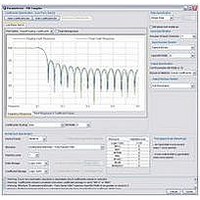IPR-FIR Altera, IPR-FIR Datasheet - Page 44

IPR-FIR
Manufacturer Part Number
IPR-FIR
Description
IP CORE Renewal Of IP-FIR
Manufacturer
Altera
Type
MegaCorer
Specifications of IPR-FIR
Software Application
IP CORE, DSP Filters And Transforms
Supported Families
Arria GX, Arria II GX, Cyclone, HardCopy, Stratix
Core Architecture
FPGA
Core Sub-architecture
Arria, Cyclone, Stratix
Rohs Compliant
NA
Function
Finite Impulse Response Compiler
License
Renewal License
Lead Free Status / RoHS Status
na
Lead Free Status / RoHS Status
na
4–2
FIR Compiler User Guide
■
■
■
■
You can adjust the number of taps, cut-off frequencies, sample rate, filter type, and
window method to build a custom frequency response. Each time you apply the
settings, the FIR Compiler calculates the coefficient values and displays the frequency
response on a logarithmic scale. The coefficients are floating-point numbers and must
be scaled.
The values are displayed in the Coefficients scroll-box, of the Coefficients Generator
Dialog box, refer to
When the FIR Compiler reads in the coefficients, it automatically detects any
symmetry. The filter gives you several scaling options, for example, scaling to a
specified number of bits or scaling by a user-specified factor.
The scaled coefficients are displayed in the Time Response & Coefficient Values tab
of the Parameterize FIR Compiler page, refer to
Coefficient Scaling
Coefficient values are often represented as floating-point numbers. To convert these
numbers to a fixed-point system, the coefficients must be multiplied by a scaling
factor and rounded. The FIR Compiler provides five scaling options:
■
■
■
■
■
Band Reject
Raised Cosine
Root Raised Cosine
Half Band (low pass)
Auto scale to a specified number of precision bits—Because the coefficients are
represented by a certain number of bits, it is possible to apply whatever gain factor
is required such that the maximum coefficient value equals the maximum possible
value for a given number of bits. This approach produces coefficient values with
the maximum signal-to-noise ratio.
Auto with a power of 2—With this approach, the FIR Compiler selects the largest
power of two scaling factor that can represent the largest number within a
particular number of bits of resolution. Multiplying all of the coefficients by a
particular gain factor is the same as adding a gain factor before the FIR filter. In
this case, applying a power of two scaling factor makes it relatively easy to remove
the gain factor by shifting a binary decimal point.
Manual—The FIR Compiler lets you manually scale the coefficient values by a
specified gain factor.
Signed binary fractional—You can specify how many digits to use on either side of
the decimal point (supported in the variable architecture only).
None—The FIR Compiler can read in pre-scaled integer values for the coefficients
and not apply scaling factors.
Figure 3–2 on page
3–3.
Figure 3–5 on page
© December 2010 Altera Corporation
Chapter 4: Functional Description
3–6.
FIR Compiler















